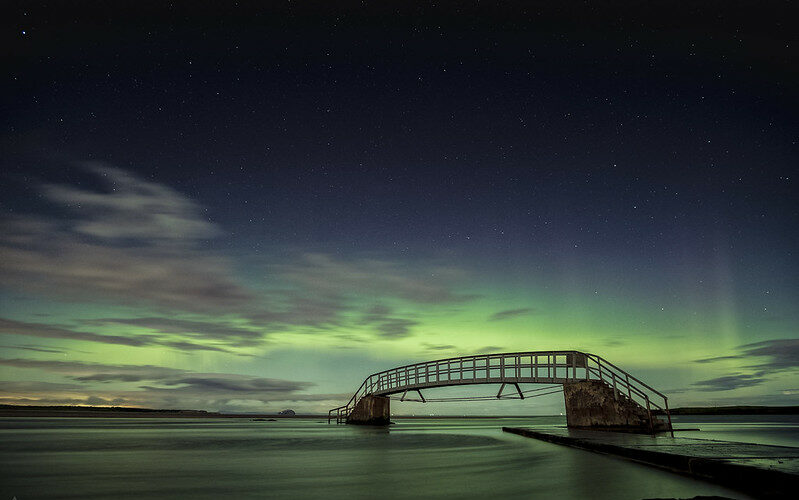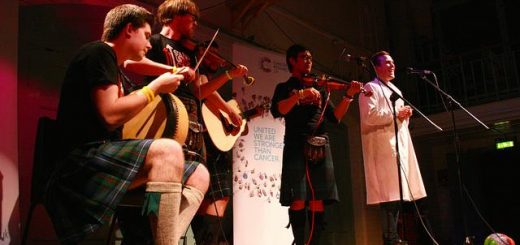How to view the Northern Lights: Solar Maximum predicted in 2024

Ethereal lights have appeared in the skies several times this aurora season so far. In the Northern Hemisphere, this atmospheric phenomenon is known as the northern lights or aurora borealis, while in the Southern Hemisphere, the southern lights or aurora australis are visible. 1
The northern lights are a prominent feature in many folktales. In Gaelic, the aurora is called na fir chlis — the nimble men. In Shetland and Orkney, the aurora is known as the mirrie dancers (or merry dancers). The word mirr comes from the old Norn language and means to shimmer, tremble or quiver. 2
If you haven’t seen the aurora yet, don’t worry. The sun is approaching the peak in its roughly 11-year cycle of activity. Solar activity is seen as variations of the sun’s magnetic field due to the motion of the sun’s plasma. The magnetic field flips as the solar cycle peaks which means the magnetic poles swap places. 3 Scientists measure the level of solar activity by the number of sunspots. Sunspots are cooler, dark regions on the sun’s surface with intense magnetic fields. A solar cycle goes from solar minimum with the fewest sunspots to solar maximum with the most, then back to solar minimum.
Krista Hammond, Manager at the Met Office Space Weather Operations Centre (MOSWOC) told us, “As space weather tends to originate from sunspot regions, it follows that when we see more sunspots, we expect an increased frequency in space weather and therefore more chances to view the Northern Lights. This is what we are seeing as we near solar maximum.” 4
The National Oceanic and Atmospheric Administration (NOAA) predicts that solar maximum will occur between January to October 2024. 5 Similarly, researchers from The Center of Excellence in Space Sciences India (CESSI) predict solar maximum to take place between January and September 2024. 6 The current solar cycle 25 is predicted to be stronger than the previous one which was the weakest in 100 years; however, its strength is still below average.
What causes the aurora?
These mesmerising lights are a result of solar activity. A stream of plasma, consisting of electrically charged particles, constantly flows from the sun as the solar wind. The sun also releases billions of tonnes of plasma from its outer atmosphere, the Corona, through enormous explosions called Coronal Mass Ejections (CMEs). CMEs usually occur near sunspots and are caused by the sun’s magnetic field realigning itself after becoming tangled. Sometimes CMEs are seen alongside solar flares — intense bursts of radiation. We can expect about one CME per week around solar minimum, but as solar activity increases we can see several CMEs per day near solar maximum. The solar wind and CMEs carry an embedded magnetic field from the sun.
Earth’s magnetic field is our shield against the solar wind. We call the space that surrounds Earth’s magnetic field, the magnetosphere. The magnetosphere also contains its own plasma. Normally the solar wind is deflected away from Earth by the magnetosphere much like water parting around the bow of a ship. 7 However, our protective shield is by no means perfect. Some charged particles can sneak in.

Artist Illustration of a Coronal Mass Ejection from the sun directed towards Earth. The blue lines extending from Earth’s magnetic poles represent the magnetic field lines. Image by NASA/GSFC/SOHO/ESA ( CC BY 2.0 DEED)
CMEs, that are directed towards Earth, and high-speed solar winds disturb Earth’s magnetic field causing geomagnetic storms; with CMEs responsible for the strongest storms. Charged particles that have become trapped in Earth’s magnetic field undergo acceleration down onto the magnetic poles. These particles then collide with atoms and molecules in Earth’s upper atmosphere causing them to glow as they release energy in the form of light. This light is the spectacular aurorae that we see.
The aurora’s colour comes from the type of gas interacting in the atmosphere. Green is the most common colour caused by oxygen at 60 miles above Earth, whereas red aurorae occur at altitudes of 100-200 miles, according to the Met Office. Nitrogen can produce blue, purple and red hues. 8
When can I see the northern lights?
The best months for viewing the aurora are September-October and March-April, around the equinoxes when geomagnetic activity is high. The best time to see the aurora is a couple of hours either side of midnight. However, when aurorae are active, they can be seen at any time as long as it’s dark. But remember that high-latitude locations have very little to no darkness in the summer.
Are the northern lights visible in Scotland?
Folks often dream of going on holiday to places in or near the Arctic Circle, such as Norway or Iceland, to chase the northern lights. These high latitude locations are the best places to see the aurora borealis as it’s centred around the magnetic north pole in a ring-shape called the aurora oval.
Shetland is the closest point to the aurora oval in the UK and when activity picks up, aurorae are frequently seen there. 9 Similarly, aurorae are often visible in Orkney and the north of Scotland. You have more chance of seeing the aurora the further north you are.
However, lately, the northern lights have been spotted all over Scotland and even in the south of England. This is because as we’re seeing solar activity increase, we expect more geomagnetic storms. “The stronger the geomagnetic storm, the further south across the UK the northern lights will be visible,” Hammond said. The aurora oval extends to lower latitudes than usual with heightened activity. But intense geomagnetic storms can occur at any time throughout a solar cycle.
What viewing conditions do I need?
Even if the aurora is active, you need the right viewing conditions. Look towards the northern horizon. The aurora is only visible at night and is best viewed under dark, clear skies with no light pollution. Moonlight can affect visibility particularly if the aurora is weak.
Scotland has lots of fantastic dark skies. You can find places with dark sky status on the International Dark Sky Association’s website. 10 There are also UK Dark Sky Discovery Sites 11 which include both rural and urban locations away from most light pollution with access for wheelchair users.
If your viewing site isn’t the best, don’t lose hope. Hammond explained, “With certain camera settings it is possible to capture a more vivid display than what is visible to the naked eye.” Try a longer exposure shot (e.g., a shutter speed of a few seconds) with your phone or digital camera 12. This is particularly useful when you’re struggling to see the aurora as your camera can capture it for you. Cameras are more sensitive to the aurora’s light than your eyes.
Keep in the loop with forecasts and alerts
Aurorae are tricky to predict, but since they are a product of space weather, forecasts can indicate potential displays.
“At the Met Office Space Weather Operations Centre, we forecast space weather events like coronal mass ejections, because the most severe space weather events can impact upon our technology, national infrastructure, and communications systems here at Earth,” Hammond explained. If CMEs are directed towards Earth they reach us within days, travelling at about 2 million mph, causing the largest geomagnetic storms and enhanced aurora.
The Met Office issues regular space weather forecasts. 13 The NOAA provides 30-minute and 3-day forecasts. 14 You can sign up for mobile notifications from AuroraWatch UK. 15 who send out real-time aurora alerts.
What will I see?
Aurorae can show different colours and structures, such as arcs, curtains, swirls and rays 16. They can move and shift across the sky. When you go outside, give your eyes time to adjust to the dark. If you need a light source, use a red light which won’t affect your vision. Also, bear in mind the aurorae usually appear much brighter in photos than to the naked eye.
And there are no guarantees when it comes to a display. “Although we can give forecasts to predict the arrival of coronal mass ejections and therefore the potential to see the aurora, the duration of the display can vary and is difficult to predict. It can be gone in minutes or last several hours,” Hammond continued.
If you’re unlucky, there are many aurora webcams online 17, including Shetland webcams 18, and at least you’ll stay nice and cosy indoors. And if you are going aurora chasing, don’t forget to wrap up with multiple layers as it’s sure to get chilly out there. Best of luck!
Edited by Chris Riggs
Copy-edited by Rachel Shannon
References
- Learn all about the aurora australis: https://www.nationalgeographic.co.uk/travel/2020/05/electric-dreams-where-to-see-the-southern-lights
- Discover more about the origins of the mirrie dancers: https://www.iheardee.com/posts/mirrie-dancers
- Learn more about the sun’s magnetic field: https://letstalkscience.ca/educational-resources/backgrounders/magnetic-sun
- Source is from email correspondence
- Check out the prediction update from NOAA here: https://www.swpc.noaa.gov/news/noaa-forecasts-quicker-stronger-peak-solar-activity
- Read more about the CESSI research: https://ras.ac.uk/news-and-press/news/solar-activity-likely-peak-next-year-new-study-suggests
- Check out this detailed look at Earth’s magnetic field and magnetosphere https://climate.nasa.gov/news/3105/earths-magnetosphere-protecting-our-planet-from-harmful-space-energy/
- Learn even more about aurorae colours from AuroraWatch UK https://wp.lancs.ac.uk/aurorawatchuk/2017/05/10/the-vivid-lights-what-causes-the-colour-of-the-aurora/
- Learn about the Shetland magnetometer here: https://wp.lancs.ac.uk/aurorawatchuk/2017/09/13/new-shetland-magnetometer/
- https://darksky.org/what-we-do/international-dark-sky-places/all-places/?_location_dropdown=scotland&_search_field=scotland
- https://www.darkskydiscovery.org.uk/dark-sky-discovery-sites/map.html
- Find aurora photography tips here: https://www.metoffice.gov.uk/weather/learn-about/space-weather/taking-photos-of-the-auroras#:~:text=Aim%20for%20a%20clear%20sky,for%20a%20more%20interesting%20picture.
- https://www.metoffice.gov.uk/weather/specialist-forecasts/space-weather
- https://www.swpc.noaa.gov/communities/aurora-dashboard-experimental
- https://aurorawatch.lancs.ac.uk/
- Discover some weird aurorae here: https://www.snexplores.org/article/newfound-dunes-is-among-weirdest-of-northern-lights
- Here’s a list of aurora webcams by country https://seetheaurora.com/webcams
- https://www.shetlandwebcams.com/






